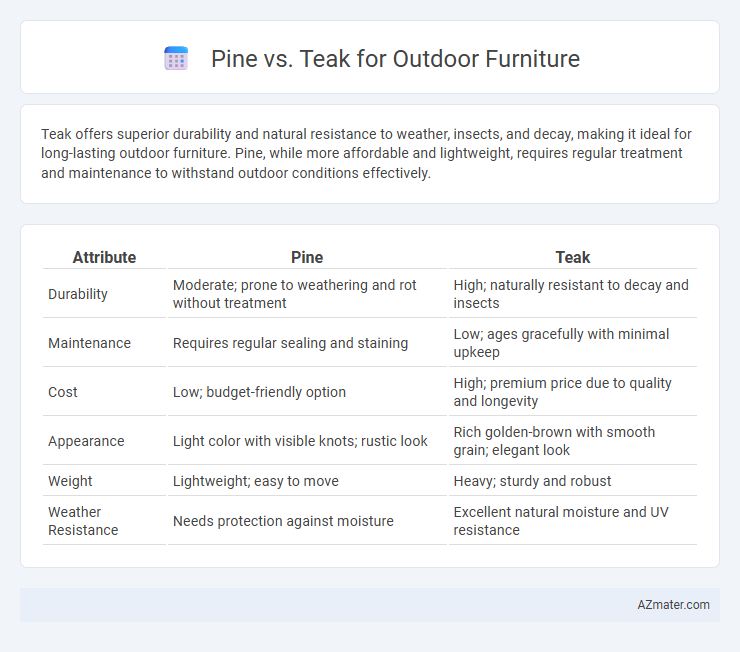Teak offers superior durability and natural resistance to weather, insects, and decay, making it ideal for long-lasting outdoor furniture. Pine, while more affordable and lightweight, requires regular treatment and maintenance to withstand outdoor conditions effectively.
Table of Comparison
| Attribute | Pine | Teak |
|---|---|---|
| Durability | Moderate; prone to weathering and rot without treatment | High; naturally resistant to decay and insects |
| Maintenance | Requires regular sealing and staining | Low; ages gracefully with minimal upkeep |
| Cost | Low; budget-friendly option | High; premium price due to quality and longevity |
| Appearance | Light color with visible knots; rustic look | Rich golden-brown with smooth grain; elegant look |
| Weight | Lightweight; easy to move | Heavy; sturdy and robust |
| Weather Resistance | Needs protection against moisture | Excellent natural moisture and UV resistance |
Introduction: Pine vs Teak for Outdoor Furniture
Pine and teak are popular choices for outdoor furniture due to their distinct properties and aesthetics. Pine is a softwood known for its affordability and ability to absorb stains, but it requires regular maintenance to resist moisture and insect damage. Teak, a dense hardwood rich in natural oils, offers superior durability, weather resistance, and an elegant aging process, making it ideal for long-lasting outdoor use.
Wood Characteristics and Appearance
Pine wood features a light color with prominent knots and a soft texture, making it easy to work with but less resistant to outdoor elements without proper treatment. Teak boasts a rich golden-brown hue, natural oils that provide excellent resistance to moisture and pests, and a dense, durable grain structure ideal for long-lasting outdoor furniture. While pine requires regular sealing and maintenance to prevent warping and decay, teak's inherent weather-resistant properties ensure longevity and minimal upkeep in outdoor settings.
Durability and Weather Resistance
Teak offers superior durability and weather resistance compared to pine, making it the preferred choice for outdoor furniture that withstands harsh elements. Its natural oils and dense grain provide exceptional protection against moisture, insects, and UV damage, ensuring long-lasting performance. Pine is more susceptible to weathering and requires regular treatment to maintain its integrity outdoors.
Maintenance Requirements
Pine outdoor furniture requires frequent sealing and staining to protect against moisture, UV damage, and insect infestation due to its softer wood properties. Teak furniture demands less maintenance because of its natural oils that resist weathering and decay, allowing it to age gracefully with minimal treatment. Regular cleaning and occasional oiling keep teak looking fresh, while pine needs more consistent upkeep to prevent warping and surface deterioration.
Cost Comparison
Pine outdoor furniture is significantly more affordable than teak, with prices often 40-60% lower due to its faster growth rate and widespread availability. Teak commands a premium price because of its natural oils, durability, and resistance to weathering, making it a long-term investment despite the higher initial cost. Choosing pine reduces upfront expenses but may incur more frequent maintenance costs compared to the lower upkeep demands of teak furniture.
Environmental Impact and Sustainability
Pine outdoor furniture typically has a lower environmental impact due to its fast growth rate and widespread availability, making it a more sustainable choice compared to teak. Teak's durability and natural resistance to decay reduce the need for chemical treatments, but slower growth and overharvesting raise concerns about deforestation and habitat loss. Choosing FSC-certified pine or teak ensures responsible forestry practices, significantly enhancing the sustainability of outdoor furniture options.
Comfort and Aesthetic Appeal
Pine outdoor furniture offers a lightweight, softer texture that enhances comfort and a natural, rustic aesthetic ideal for casual settings. Teak, known for its dense, oily grain, provides superior durability and a smooth finish that ages beautifully to a silver-gray patina, lending an elegant and timeless appeal. The choice between pine and teak hinges on balancing the desire for immediate comfort against long-term aesthetic resilience in various weather conditions.
Common Uses in Outdoor Settings
Pine is commonly used for outdoor furniture such as garden benches, picnic tables, and Adirondack chairs due to its affordability and ease of staining or painting for weather resistance. Teak is highly favored for premium outdoor furniture like dining sets, loungers, and patio benches because of its natural oils and dense grain, which provide exceptional durability and resistance to moisture, insects, and decay. Both woods require maintenance, but teak's inherent weather-resistant properties reduce the need for frequent treatment compared to pine.
Pros and Cons: Pine vs Teak
Pine outdoor furniture offers affordability and lightweight characteristics, making it easy to move and ideal for budget-conscious buyers, but it is less durable and requires frequent sealing to prevent weather damage. Teak furniture is highly durable and naturally resistant to water, insects, and rot, providing long-lasting outdoor use with minimal maintenance, though it comes with a higher initial cost and heavier weight. Choosing between pine and teak depends on balancing cost, maintenance commitment, and desired furniture longevity.
Final Recommendations for Outdoor Furniture Buyers
Teak offers superior durability, natural resistance to insects, moisture, and decay, making it the optimal choice for long-lasting outdoor furniture despite its higher cost. Pine is more affordable and lightweight but requires regular treatment to prevent weather damage and has a shorter lifespan under outdoor conditions. For buyers prioritizing longevity and minimal maintenance, teak is the best investment, while pine suits budget-conscious buyers willing to perform ongoing upkeep.

Infographic: Pine vs Teak for Outdoor Furniture
 azmater.com
azmater.com